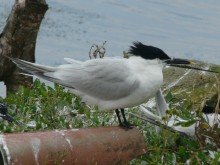Generally speaking, and I mean generally not specifically, birds set up territories in April, build nests and lay eggs in May, feed their young during June and the young fledge in July. The timing varies by species depending on available food supplies for their young but, as a rule of thumb, it works. July is the month of fledglings and there is plenty of evidence of some notable breeding successes this year. The advent of small outdoor cameras means several nests can be followed in various locations during the season and as a result of these cameras we know barn owls bred successfully at Lorton Meadows, kestrels bred successfully at Hengistbury and hobbies are doing well at Arne. Other birds of prey have done well with the nationally scarce marsh harrier breeding on both RSPB reserves in Weymouth at Radipole and Lodmore. Peregrines raised young in the centre of Bournemouth on the university building in Lansdowne and there was a rare breeding success in Dorset for goshawk at an undisclosed location.
On the coast the little terns on Chesil beach did very well with an estimated seventy plus young from around forty nests thanks to twenty-four hour surveillance and protection from a dedicated team of voluntary wardens. Anti-predation measure invoked on the lagoon on Brownsea island helped the colonies of sandwich terns and common terns do well this year too. Also on Brownsea two pairs of avocet hatched four young but sadly none of the young survived but this was the first breeding record in Dorset for many, many years, if ever. Another first breeding success this year came with a pair of cattle egret raising young, again at an undisclosed location. There had been some anticipation that the cattle egret might spread its range into Britain and after increasing numbers have been seen here in recent years so to now have proof of breeding is wonderful news. Gulls may have done quite well too with large numbers of immature Mediterranean gulls being seen, many of whom would have been born and raised here in Dorset. There were also a lot of yellow-legged gull young about but it is thought that this year none were hatched in Dorset, maybe some in Hampshire though.
A small number of vagrant species of birds turned up as usual with common rosefinch, Bonaparte’s gull, great white egret and roseate terns all around for a while. A summer storm with westerly gales brought a rare sighting this far east of a great shearwater and also brought Cory’s, Balearic and sooty shearwaters this way in small numbers too. Storm petrels also came in on the winds. The storm may also have accounted for sightings of bottle-nosed dolphins, harbour porpoises, a basking shark and a sun fish.
Away from birds the main news in July was the scarlet darter dragonfly that was found at Longham Lakes, possibly only the sixth records in Britain and the first for Dorset. Other once scarce species like red-veined darter, lesser emperor and scarce chaser along with small red-eyed damselflies were seen in good numbers in favourable locations which seems to suggest our water courses are improving in quality and probably warming up and are less prone to freezing in winter.
The main butterfly feature was the annual emergence of Lulworth skipper, although there were few records tweeted for our very own butterfly. However, the Essex skipper did bring in a number of tweets and shows that this is another species that may be spreading and bucking the increasing trend of diminishing butterfly populations. Some rare moths turned up in light traps with bedstraw hawk-moth, splendid brocade and ringed border being particularly interesting. By day Jersey tiger, cream-spot tiger, scarlet tiger and hummingbird hawk-moth were all seen.
The early part of the month was fine and warm and was ideal weather for insects but as the month wore on so the wind increased, the skies were more often grey and bands of rain swept through which had a negative impact on insects in particular. As the month approached its end there were signs that the autumn migration was beginning with small numbers of waders returning to our shores and warblers seen heading south.
See the full list of sightings for July here: https://www.natureofdorset.co.uk/records-diary/july-2017
Peter Orchard












